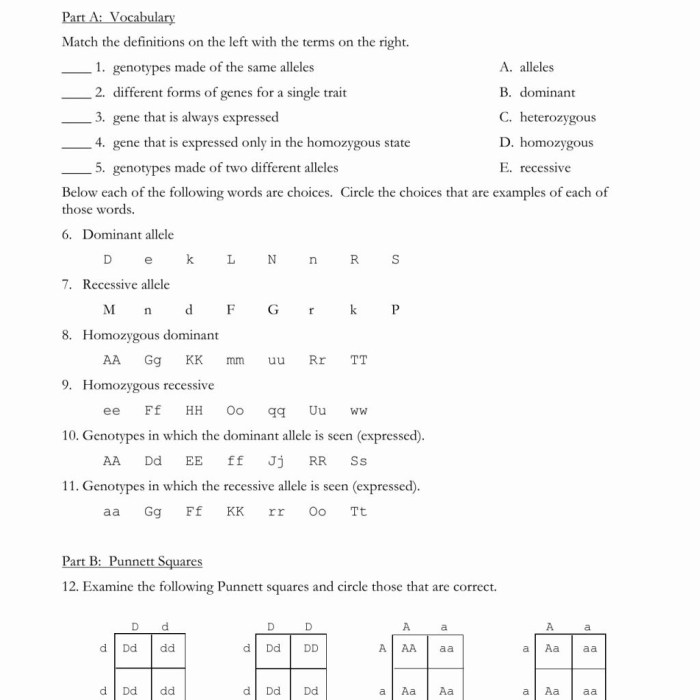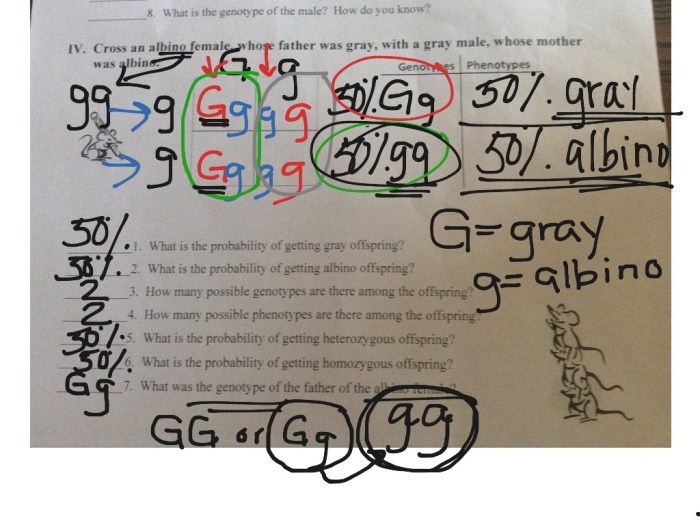The practice monohybrid crosses answer key unlocks the secrets of genetic inheritance, providing a comprehensive guide to the fundamental principles that govern the transmission of traits from one generation to the next. This key offers a detailed exploration of monohybrid crosses, their applications, and the variations that shape the inheritance patterns of traits.
Through a step-by-step approach, this answer key empowers learners to conduct practice monohybrid crosses with precision, determining parental genotypes, predicting offspring genotypes and phenotypes, and unraveling the complexities of genetic inheritance.
1. Definition of Monohybrid Crosses: Practice Monohybrid Crosses Answer Key

Monohybrid crosses are a type of genetic experiment in which individuals with different forms of a single gene are mated to study the inheritance of that gene. The purpose of monohybrid crosses is to determine the genotypes and phenotypes of the offspring and to understand the principles of Mendelian inheritance.
Monohybrid crosses are significant in genetics because they provide insights into the basic principles of heredity and help predict the outcomes of genetic crosses. They form the foundation for understanding more complex inheritance patterns and have applications in fields such as agriculture, medicine, and genetic counseling.
2. Procedure for Practice Monohybrid Crosses

Step 1: Determine Parental Genotypes
Examine the given information to determine the genotypes of the parental individuals. Genotypes can be represented using letters, where dominant alleles are written in uppercase and recessive alleles in lowercase (e.g., AA, Aa, aa).
Step 2: Write Gametes
For each parent, write the possible gametes they can produce. Gametes are haploid cells (containing half the number of chromosomes) that carry one allele for each gene. For a heterozygous parent (Aa), the gametes will be A and a. For a homozygous dominant (AA), the gametes will be only A, and for a homozygous recessive (aa), the gametes will be only a.
Step 3: Predict Offspring Genotypes and Phenotypes, Practice monohybrid crosses answer key
Create a Punnett square to combine the gametes from each parent and predict the possible genotypes and phenotypes of the offspring. The genotype refers to the genetic makeup of an individual, while the phenotype refers to the observable traits.
3. Example Practice Monohybrid Crosses

| Parental Genotypes | Gametes | Expected Offspring Genotypes | Expected Offspring Phenotypes |
|---|---|---|---|
| AA x aa | A, a | Aa | All dominant phenotype |
| Aa x Aa | A, a | AA, Aa, aa | 3:1 dominant to recessive phenotype |
| aa x aa | a, a | aa | All recessive phenotype |
4. Variations in Monohybrid Crosses
Incomplete Dominance
Incomplete dominance occurs when neither allele is completely dominant over the other. Instead, the heterozygous genotype exhibits a phenotype that is intermediate between the phenotypes of the homozygous dominant and homozygous recessive genotypes.
Codominance
Codominance occurs when both alleles are fully expressed in the heterozygous genotype. In such cases, both phenotypes are clearly visible in the offspring.
5. Applications of Monohybrid Crosses
Monohybrid crosses have practical applications in various fields:
- Agriculture:Plant breeders use monohybrid crosses to develop new varieties with desired traits, such as increased yield, resistance to pests, or improved nutritional value.
- Medicine:Monohybrid crosses are used in genetic testing to identify individuals who carry specific genetic disorders or are at risk of developing them.
- Genetic Counseling:Monohybrid crosses help genetic counselors predict the probability of inheriting genetic traits and provide guidance to families with a history of genetic disorders.
FAQ Insights
What is the purpose of a practice monohybrid cross?
Practice monohybrid crosses provide a hands-on approach to understanding the principles of Mendelian inheritance, allowing learners to predict the outcomes of genetic crosses and explore the patterns of trait transmission.
How do I determine the parental genotypes in a monohybrid cross?
Parental genotypes can be determined by analyzing the phenotypes of the parents and using Punnett squares to predict the possible combinations of alleles.
What is the significance of incomplete dominance in monohybrid crosses?
Incomplete dominance occurs when neither allele is dominant, resulting in an intermediate phenotype in the offspring. This variation highlights the complex interactions between alleles and their effects on trait expression.